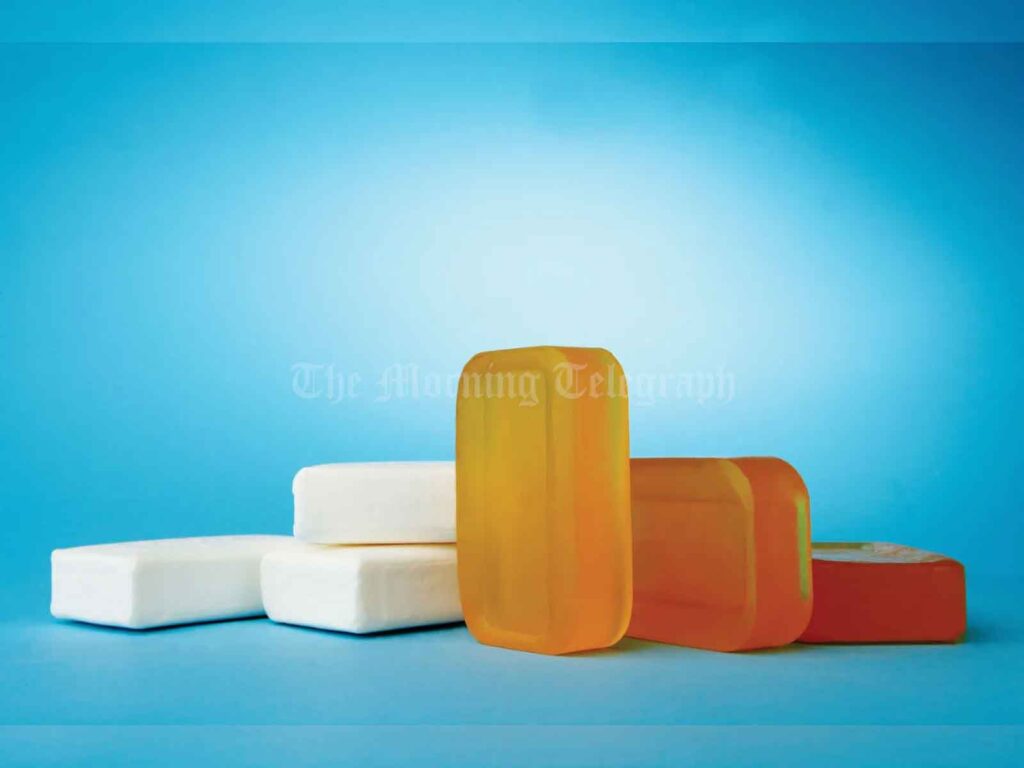
- The lower the TFM value, the lower the bar’s ability to clean the body or fabric
- There are many loopholes in the Sri Lanka Standards Institute’s testing methods that allow theft and fraud
- Those loopholes are not self-made. They are deliberately designed
- If you want to shut down the Standards Institute and Consumer Authority, here are 4 recommendations from me
Can consumers be assured that they are getting a product with the correct TFM value when purchasing baby soap, body wash or bedin bars? This is a very important scientific explanation about it
Soap is a product used as a cleanser dating back thousands of years to the ancient Babylonian civilization. In terms of composition, it is a ‘basic salt of a fatty acid’. Soap is produced using fatty acids contained in vegetable oils such as coconut oil, palm oil and animal oils. Soap Noodles and Distilled Fatty Acids obtained from vegetable oil are used as the main ingredients for soap and bathin bar products in Sri Lanka today. TFM (Total Fatty Matter) value is considered as a percentage of the amount of plant fatty acids contained in soap or beverage bars produced in this way.
The Total Fatty Acid Amounts (TFM) used in soap or bathin bar products is used as a measure of the cleansing ability of all soaps and bathin bars. The following table shows the Sri Lanka Standards Institute (SLSI) approved and published minimum TFM values for each soap and bathing bar product.

According to the information in the table,
- No artificial detergents are allowed to be added to baby soaps or body washes.
- Laundry soaps without artificial detergents also do not have the possibility to add artificial detergents.
- A minimum TFM value of 78% for baby soaps, a minimum TFM value of 76.52 for body soaps and a minimum TFM value of 59% for synthetic detergent free laundry soaps is mandatory.
- The ethanol insoluble matter that can be used is mandated to be subject to a maximum value of 1.5% for baby soap, a maximum value of 2% for body wash soap and a maximum value of 22% for laundry soap without synthetic detergents.
- Under the Bedin Bar standard, there is no maximum limit for ethanol insoluble matter, so it appears that manufacturers can use those matters as they wish.
Can the consumer tell the difference between a body soap and a drinking bar?
Although there are two Sri Lankan Standards (SLS Standards) for body wash soap (SLS 34:2009) and Bathing Bar (SLS 1220:2016), the relevant regulatory bodies or manufacturers are not informing consumers to correctly identify the difference between the two types of products. can’t see The regulations for labels provided under the body lotion and bathing bar standards do not mandate that the product be displayed on the front of the package accurately. Therefore, some manufacturers have been given the opportunity to sell bedin bars produced with a lower TFM value than body burning soap under the name ‘Aga Galvana Saban’.
Due to the testing methods recommended for determining the TFM value of baby soap and body soap and the deficiencies in the method of calculating the TFM value, some manufacturers have the opportunity to release and sell products that should belong to the Bedin bar category under the categories of baby soap and body soap. provided.
Are consumers well-informed enough to clearly and accurately distinguish between baby soap, body wash and bathing bars?
According to my understanding and knowledge, the people of our country do not have such understanding or knowledge. Therefore, as a law-abiding Sri Lankan citizen with many years of experience in the soap industry and a sound scientific knowledge of soap products, I would like to clarify some important facts about soaps and bathing bars to the Sri Lankan consumer public and relevant regulatory bodies through this letter. If the points I mention are well understood, the regulatory bodies can make rules so that manufacturers cannot mislead the consumers while selling soaps and drinking bars. Also, consumers will be able to choose the right product with higher quality.
According to the information in the table, it is mandatory to have a minimum TFM value of 782 for baby soap and a minimum TFM value of 76.5% for body soap. However, according to the SLS standard for split bars (SLS : 1220:201) its minimum TFM value is allowed to be reduced up to 40%. When reducing the TFM value, at the same time its cleaning ability also decreases, in order to increase the cleaning ability that decreases, the SLS standard has made it mandatory to add not less than 2% synthetic detergent to the bars.
Synthetic detergents have a stronger detergency than the mild detergency of fatty acids derived from vegetable oils or animal oils. Therefore, by adding 2% to 3% artificial detergents, bedin bar manufacturers are able to reduce the TFM value by about 18%. Bedin bar manufacturers use ingredients such as Kaolin or Talc, which are very cheap, in order to reset the weight of the product that is reduced compared to the amount that is reduced when reducing the TFM value. Those ingredients are called fillers and thus the cleaning ability of the product is not high.However, manufacturers are also able to increase the weight of the bedin bar product and adjust the structure of the bedin bar cube at a very low cost compared to the amount of removed fatty acids (TFM).
What is the recommended test method for calculation of Sri Lanka standards and TFM value?
The test method defined for calculating the TFM value of baby soaps and body soaps has such shortcomings or gaps that it is not possible to determine the correct TFM value. It appears that due to those deficiencies or gaps, the manufacturers have been given the opportunity to claim a higher TFM value than the actual TFM value of those products.
I will describe the shortcomings of the above mentioned test methods later in this article. Before that, the readers can get a clearer understanding by examining the test method that tests the TFM value of bedin bars and synthetic detergent-free laundry soaps. Under SLS 554: 2016, Appendix B’ and ‘SLS 1220: 2016 Appendix D’ testing procedures, those standards recommend removing the ‘matter insoluble in ethanol’ contained in Bedin bars. After doing that TFM value should be calculated. The fillers mentioned above are not soluble in ethanol. Therefore, by removing the amount of insoluble matter in ethanol, the weight of the fillers (fillers) is not included in the calculation of the TFM value. The percentage of TFM in soap or bedin bars is the most important factor in determining the quality of that product. Therefore, the test method to calculate the TFM value correctly is very important. When there are flaws or gaps in the testing method, it gives the manufacturers the opportunity to mislead the consumers and sell products with a low TFM value as products with a high TFM value.
The Sri Lanka Standards Institute and other regulatory authorities should take immediate action to make it mandatory for manufacturers to state only the correct TFM value on soap or bathin bars by recommending a test method that does not have flaws or gaps. Until this is done, some manufacturers are tempted to increase their profits by selling products of inferior quality and quality with a higher TFM value by adding more fillers.
‘SLS 554: 2016, Appendix (Appendix) B’ and ‘SLS 1220: 2016 Appendix (Appendix) D’ are test methods that appear in the study of the amount of matter insoluble in ethanol in the respective products’ (‘matter insoluble in ethanol’) i.e. filler ingredients. The correct TFM value should be calculated after removing the effect caused by the weight of substances such as (fillers). Therefore calculation of TFM value only after deducting the weight of ethanol insoluble matter is mandatory for soaps or bathin bars where condition is determined based on TFM value. If this is not done, it is impossible to avoid misleading the consumers as well as selling inferior quality products in the market.
Let’s consider the recommended ISO 65 test method for calculating the TFM value of baby soaps and body washes.
As mentioned above, there should be a test method to obtain the TFM value correctly, but by the current method (ISO 685) of TFM calculation recommended in standards for both baby soap (SLS 547:2009) and body soap (SLS 34:2009), the TFM value is calculated. It is not mandatory to eliminate the effect caused by the amount of insoluble matter in ethanol.
In baby soap (SLS 547:2009) and body soap (SLS 34:2009), it is recommended under the above SLS standards that the removal of additional substances other than fatty substances by a filtration step (if necessary) can be done only. . This is a significant shortcoming of the TFM calculation process in the TFM test method specified in the Baby Soap (SLS 547:2009, ISO 685) and Body Casting Soap (SLS 34:2009, ISO 685) standards.
If the ISO 685 test method recommended for those products is used in calculating the TFM value of a bar of baby soap or body soap that contains a large amount of fillers, the weight of the above-mentioned fillers will also be added to the final TFM value and the value will be wrong. Gives an increased TFM value. Thus, an incorrect TFM value is obtained because the ISO 685 test method recommends dissolving the sample to be tested in hot water instead of ethanol or other alcoholic solution. Unlike ethanol or other organic solvents, the above-mentioned fillers dissolve easily in hot water. Then, since the fillers cannot be separated and removed, it is not possible to obtain an accurate analysis of the contents of the soap or bedin bars using the above method.
It is a notable shortcoming of the above recommended test method (ISO 685) for calculating the TFM value of baby soaps and body washes. That shortcoming allows some manufacturers to add fillers to their products to declare an incorrect TFM value higher than the correct TFM value of baby soap and body soap.
Under that situation, some soap and bathing bar manufacturers have been given an opportunity to mislead consumers and sell products with a TFM value lower than the recommended minimum TFM value but containing cheap fillers or artificial cleaners by calling them baby soaps or body soaps. .
Now I suggest measures that can be considered to ensure consumer rights by correcting those deficiencies
Based on the scientific point of view I mentioned above, the relevant government agencies can consider the following measures to ensure that consumers buy products with the correct TFM value when purchasing soaps and drinking bars.
- Mandating the manufacturers to clearly mention the product type on the front panel of the product packaging i.e. ‘baby soap, body soap or ‘bathing bar’ and the relevant minimum TFM value.
- Under SLS 547:2009 and SLS 34:2009, in order to correct the deficiencies I have mentioned above in the ISO 65 test method, the filter step has been amended to “mandatory” instead of “if necessary”. doing
(For example, the American Oil Chemists Society method Db 2-48-2024 clearly states that the test sample should be filtered to determine the TFM value.) - Revising the test method of baby soap (SLS 547:2009, ISO 685) and body soap (SLS 34:2009, ISO 685) by incorporating the analytical strategy to reduce the ‘content of ethanol insoluble matter’.
(For example, the American Oil Chemists Society Db 2-48-2024 method for determining the TFM value clearly states that an alcoholic solution should be used and filtered) - If it is difficult to implement the 2nd and 3rd recommendations above, it is recommended to do the test method for calculating the TFM value of baby soap and body soap under the same method of dividing bar test (SLS 1220: 2016 Appendix D).
(Professor of Biochemistry at the Institute of Biochemistry, Molecular Biosciences and Biotechnology, University of Colombo and former President of Sri Lanka Cosmetic Manufacturers Association Prof. Nimal Punyasiri)
Source :- CEYLONWIRE




